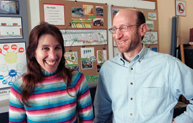Street smarts
Since the School of Urban Planning’s inception nearly 60 years ago, the school has made practicums a regular requirement for their students, who survey, study and present their recommendations to the city on living conditions in neighbourhoods-in-need. Now clients approach the school to request professional-level reports from the second-year master's practicum.

Urban planning professors Lisa Bornstein and Raphaël Fischler in front of a student project looking at neighbourhood facilities.
Owen Egan
Working with the community became an urgent task when McGill converted a factory in down-at-the-heels St Henri into student residence Solin Hall in 1990. Local activists feared that the influx of rich kids would lead to gentrification, professor Raphael Fischler says, and so McGill came up with a plan to invest the energy of the university and its students into looking at the area's housing and living conditions.
Fischler and colleague Lisa Bornstein explain that McGill's urban planners look at housing conditions, access to public transit, safety, as well as the quantity and quality of neighbourhood facilities such as parks, community meeting spaces, health services or daycare. Are these easily accessible to all, including the disabled or elderly? "Where are the elevators in the metro system?" bemoans Bornstein. Another consideration is whether commercial main streets are thriving, or do they need a facelift? Would it be better to shorten the main shopping drag and convert some commercial spaces into residential units?
Bornstein says that they often pick neighbourhoods in transition or trouble. "How do you improve a neighbourhood?" Fischler asks. "Does salvation lie in attracting richer people?" Though gentrification can boost the economy of an area, it can also drive poor people out to the city periphery where public facilities are scant. "Do we try to introduce gentrification, or what may lead to gentrification? Or do we try to not promote it?" Bornstein says. "It's a major issue, it comes up every time."
Though it's tough to say what makes a neighbourhood the next "cool" place for well-off people to move into, there are ways of minimizing the negative impacts of such a movement. The city can provide support to community organizations, participate in the financing of housing co-ops, prevent condominium conversations and slow the speed of change.
The collaboration between McGill and the communities is valuable to students, too. They walk the streets, talk to local stakeholders and conduct in-depth historical and social-demographic analyses. As well, Fischler says that the feedback students receive from community members and city councillors leads many of them to change their pre-conceived ideas of what's right for a neighbourhood and its residents.

